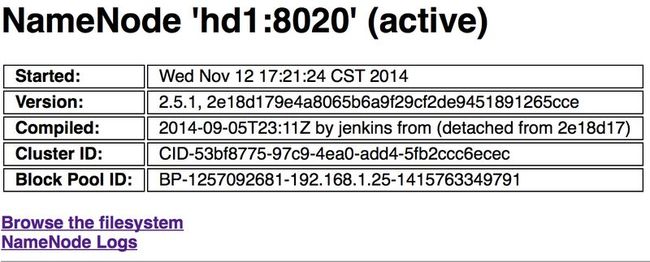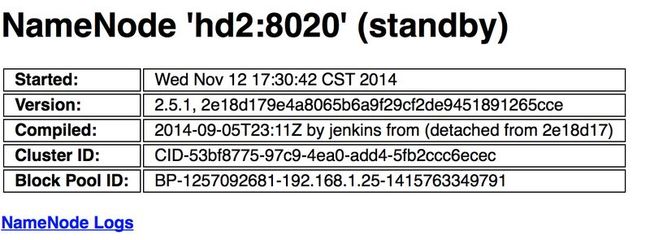this article is the another part follow to hadoop 2.x-HDFS HA --Part I: abstraction ,and here will talk about these topics:
2.installation HA
2.1 manual failover
2.2 auto failover
3.conclusion
2.installation HA
2.1 manual failover
for this mode,the cluster can be failovered by manually using some commands,but it's hard to know when/why this issuse occures.of course ,this is better than nothing:)
here are the assignments my cluster:
| host |
NN |
DN |
JN |
| hd1 |
y |
y |
y |
| hd2 |
y |
y |
y |
yes,in general,the number of journalnode is recommanded to be a odd number for max utilization,but here is just for validaing the function of HA,so it's passed also!
upon on the configs in install hadoop-2.5 without HDFS HA /Federation ,there are some changes of properties to be added or alternated,
| mode |
property to be added /alternated |
value |
abstract |
| HA manual failover |
dfs.nameservices |
mycluster |
logic name of this name service, |
| |
dfs.ha.namenodes.mycluster |
nn1,nn2 |
the name is formated by: dfs.ha.namenodes.#serviceName#; and this name service contains two namenodes |
| |
dfs.namenode.rpc-address.mycluster.nn1 |
hd1:8020 |
the internal communication addr |
| |
dfs.namenode.rpc-address.mycluster.nn2 |
hd2:8020 |
|
| |
dfs.namenode.http-address.mycluster.nn1 |
hd1:50070 |
the web ui address |
| |
dfs.namenode.http-address.mycluster.nn2 |
hd2:50070 |
|
| |
dfs.namenode.shared.edits.dir |
qjournal://hd1:8485;hd2:8485/mycluster |
|
| |
dfs.client.failover.proxy.provider.mycluster |
org.apache.hadoop.hdfs.server.namenode. ha.ConfiguredFailoverProxyProvider |
|
| |
dfs.ha.fencing.methods |
sshfence |
|
| |
dfs.ha.fencing.ssh.private-key-files |
/home/hadoop/.ssh/id_rsa |
|
| |
dfs.ha.fencing.ssh.connect-timeout
|
10000 |
|
| |
fs.defaultFS |
hdfs://mycluster |
the suffix of this value must be same as property 'dfs.nameservices' set in hdfs-site.xml |
| |
dfs.journalnode.edits.dir |
/usr/local/hadoop/data-2.5.1/journal |
|
2.1.2 steps to startup
these steps below are order-related.
2..1.2.1 startup journalnode
go to all journalnodes,and run
sbin/hadoop-daemon.sh start journalnode
2.1.2.2 go to first NN and format followed by start
hdfs namenode -format
hadoop-daemon.sh start namenode
then go to the remain JN nodes,to get the fs image,run by
bin/hdfs namenode -bootstrapStandby
sbin/hadoop-daemon.sh start namenode
2.1.2.3 spawn datanode
sbin/hadoop-daemons.sh start datanode
now,both namenodes are all kept in 'standby' state(yes,this is the defult action by manual mode,if you want to set a default active namenode ,use the auto-failover mode instead in this page)
here,u can use some commands to transition standby to active and vice-versa
hadoop@ubuntu:/usr/local/hadoop/hadoop-2.5.1/etc/hadoop-ha-manual$ hdfs haadmin
Usage: DFSHAAdmin [-ns <nameserviceId>]
[-transitionToActive <serviceId> [--forceactive]]
[-transitionToStandby <serviceId>]
[-failover [--forcefence] [--forceactive] <serviceId> <serviceId>]
[-getServiceState <serviceId>]
[-checkHealth <serviceId>]
[-help <command>] a.transition a standby namenode
nn1 To active ,return nothing if it's already active
hdfs haadmin -transitionToActive nn1
b.check whether nn1 is in active state
hdfs haadmin -getServiceState nn1
it will return
active result
c.then will check its healthy
hdfs haadmin -checkHealth nn1
return nothing if it's healthy,else some 'connection excpetion will show ' here
d.yes,u can also failover from a dead namenode to another one to get active
hdfs haadmin -failover nn1 nn2
here switch state from nn1(active) to nn2(standby).if u specify optioin '--forcefence' then the namenode nn1 will be killed also for fencing!so this is prudent.
e.and stop-dfs.sh will shutdown all processes in cluster,and start-dfs.sh will spawn up all them
stop-dfs.sh
start-df.sh
hdfs haadmin -transitionToActive nn1
by now ,we can see the nn1 is in active,and 'standby' for nn2


below are the orders of stop and start:
start order :
hadoop@ubuntu:/usr/local/hadoop/hadoop-2.5.1$ start-all.sh
This script is Deprecated. Instead use start-dfs.sh and start-yarn.sh
Starting namenodes on [hd1 hd2]
hd1: starting namenode, logging to /usr/local/hadoop/hadoop-2.5.1/logs/hadoop-hadoop-namenode-ubuntu.out
hd2: starting namenode, logging to /usr/local/hadoop/hadoop-2.5.1/logs/hadoop-hadoop-namenode-bfadmin.out
hd1: datanode running as process 1539. Stop it first.
hd2: datanode running as process 3081. Stop it first.
Starting journal nodes [hd1 hd2]
hd1: journalnode running as process 1862. Stop it first.
hd2: starting journalnode, logging to /usr/local/hadoop/hadoop-2.5.1/logs/hadoop-hadoop-journalnode-bfadmin.out
Starting ZK Failover Controllers on NN hosts [hd1 hd2]
hd1: zkfc running as process 2090. Stop it first.
hd2: zkfc running as process 3388. Stop it first.
starting yarn daemons
starting resourcemanager, logging to /usr/local/hadoop/hadoop-2.5.1/logs/yarn-hadoop-resourcemanager-ubuntu.out
hd2: starting nodemanager, logging to /usr/local/hadoop/hadoop-2.5.1/logs/yarn-hadoop-nodemanager-bfadmin.out
hd1: starting nodemanager, logging to /usr/local/hadoop/hadoop-2.5.1/logs/yarn-hadoop-nodemanager-ubuntu.out
shutdown order(same as starting):
hadoop@ubuntu:/usr/local/hadoop/hadoop-2.5.1$ stop-all.sh
This script is Deprecated. Instead use stop-dfs.sh and stop-yarn.sh
Stopping namenodes on [hd1 hd2]
hd1: stopping namenode
hd2: stopping namenode
hd1: stopping datanode
hd2: stopping datanode
Stopping journal nodes [hd1 hd2]
hd1: stopping journalnode
hd2: stopping journalnode
Stopping ZK Failover Controllers on NN hosts [hd1 hd2]
hd1: stopping zkfc
hd2: stopping zkfc
stopping yarn daemons
no resourcemanager to stop
hd1: no nodemanager to stop
hd2: no nodemanager to stop
no proxyserver to stop
--------------
now u can test some failover cases:
hdfs dfs -put test.txt /
kill #process-of-nn1#
hdfs haadmin -transitionToActive nn2
# test whether the first nn1 's edits are synchronised to nn2?yes of course,you will see the file lied there correctly
hdfs dfs -ls /
------------------
below is a test of killing the journalnode to check the cluster's robust
after stop hd1's journalnode,this causes the hd1's(same host) namenode to be killed :
2014-11-12 16:45:15,102 WARN org.apache.hadoop.hdfs.qjournal.client.QuorumJournalManager: Took 10008ms to send a batch of 1 edits (17 bytes) to remote journal 192.168.1.25:8485
2014-11-12 16:45:15,102 FATAL org.apache.hadoop.hdfs.server.namenode.FSEditLog: Error: flush failed for required journal (JournalAndStream(mgr=QJM to [192.168.1.25:8485, 192.168.1.30:8485], stream=QuorumOutputStream starting at txid 261))
org.apache.hadoop.hdfs.qjournal.client.QuorumException: Got too many exceptions to achieve quorum size 2/2. 1 successful responses:
192.168.1.30:8485: null [success]
1 exceptions thrown:
192.168.1.25:8485: Call From ubuntu/192.168.1.25 to hd1:8485 failed on connection exception: java.net.ConnectException: Connection refused; For more details see: http://wiki.apache.org/hadoop/ConnectionRefused
note the msg:Got too many exceptions to achieve quorum size 2/2. 1 successful responses....1 exceptions thrown:
=============
2.2 auto failover
the so-called 'auto failover' is the opposite of 'manual failover',the former uses a coordination-system(ie.zookeeper) to automatically recover the namenodes if some failures occure,e.g hardware faults,soft ware bugs,etc.when these problems issue the HA will detect which namenode is failed from active(not standby).then the standby nn will undertake the role which prior was 'active'.
here are some configs besides from manual failover's:
| property to be added /alternated |
value |
abstract |
| dfs.ha.automatic-failover.enabled |
true |
auto failover when possible |
|
|
hd1:2181,hd2:2181 |
yes ,u can see,both journalnode and zookeeperrole here are only even number,but it's ok for test also! |
| |
|
|
and the zkfc (zk client used in namenode to detect failures) roles are like this:
| host |
nn |
jn |
dn |
zkfc(new) |
| hd1 |
y |
y |
y |
y |
| hd2 |
y |
y |
y |
y |
2.2.1 steps to startup
a.format zk
hdfs zkfc -formatZK
b.start all
start-dfs.sh
this includes the nn,jn,dn and zkfc processes.
now just do what u want to do,the auto failover will function properly,have a nice experience for that!
ref:
Hadoop 2.0 NameNode HA和Federation实践

